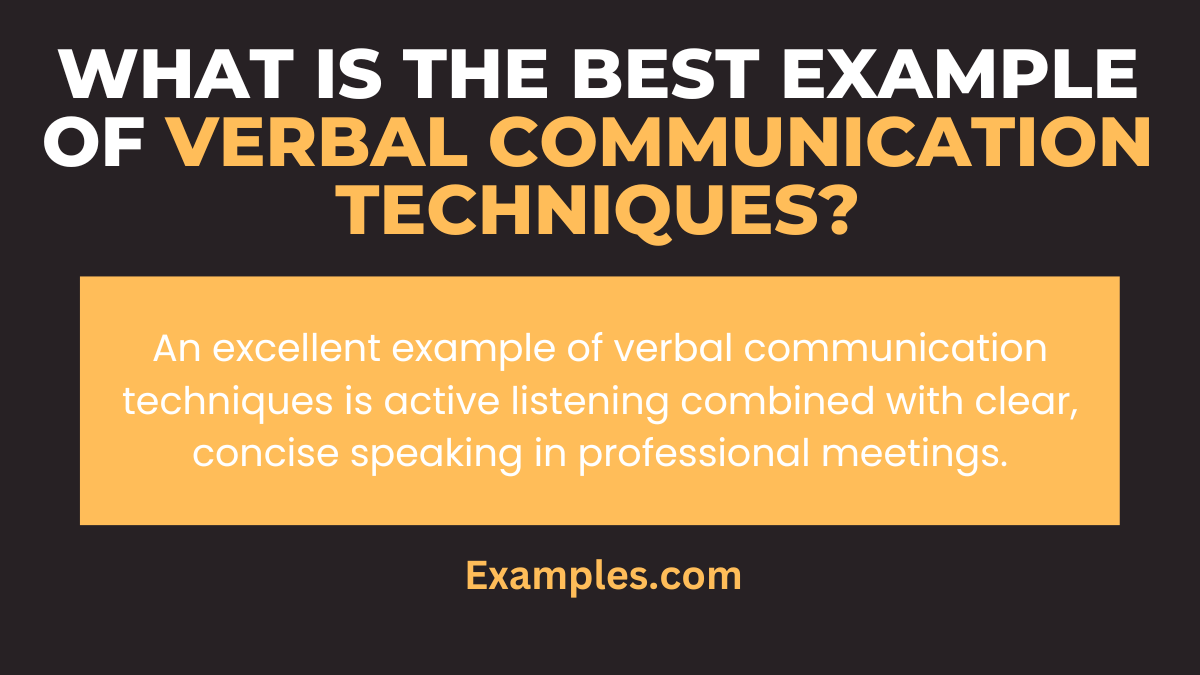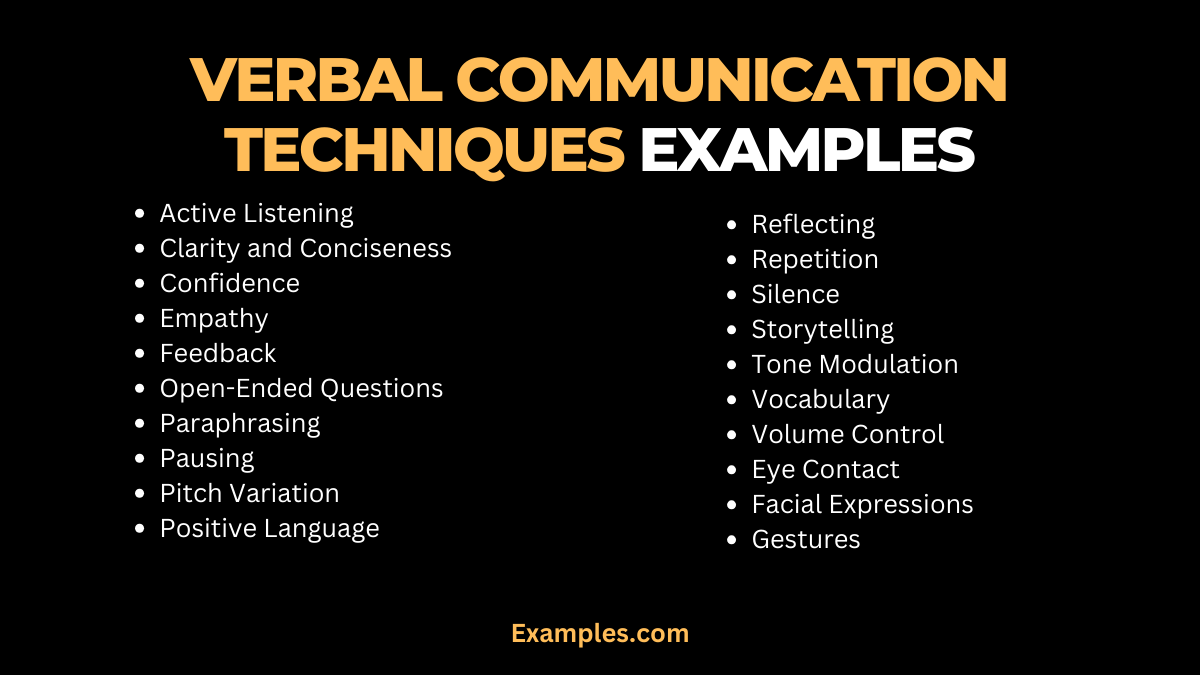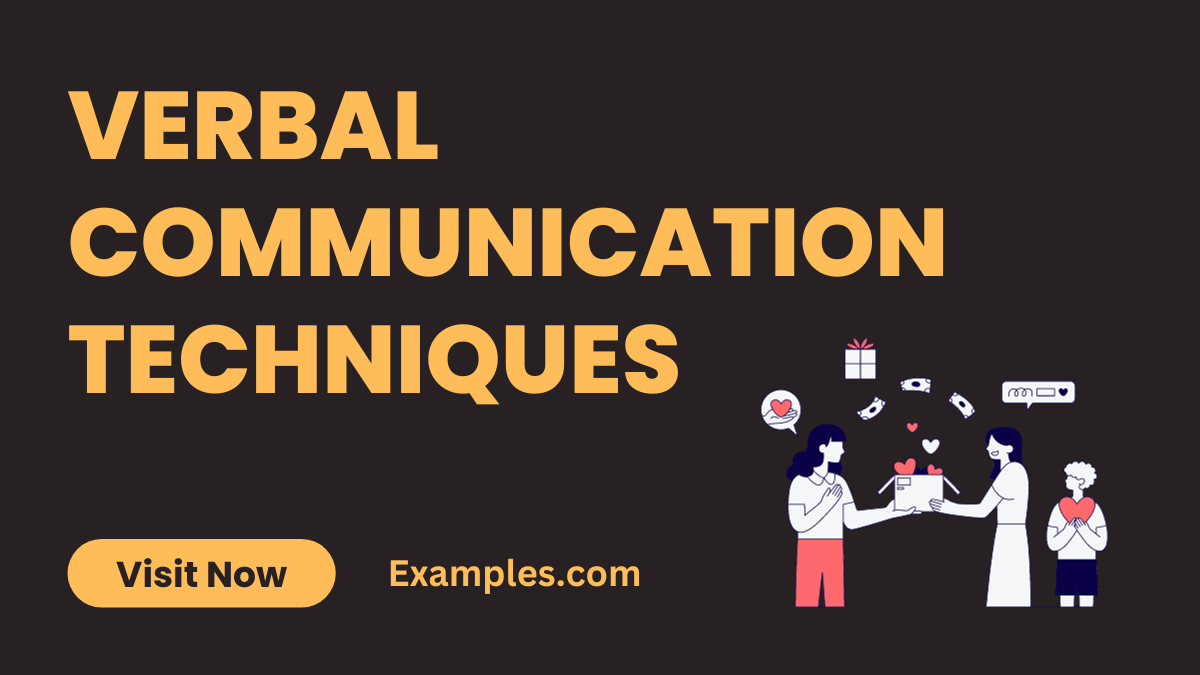Verbal Communication Techniques
Embark on a journey to master Verbal Communication Techniques with this comprehensive guide. Packed with practical Communication Examples, this resource is designed to enhance your speaking skills in various settings. From persuasive speaking methods to the art of conversation, learn how to effectively express and convey your ideas. Discover tips and techniques that will transform your interpersonal communication, making you a more effective and confident speaker in both personal and professional realms.
Download How to Improve Verbal Communication Techniques Skills PDF
What are Verbal Communication Techniques? – Meaning

Verbal communication techniques are methods and strategies used to convey messages and ideas effectively through spoken words. These techniques encompass various aspects like tone, clarity, pace, volume, and the use of language to enhance the quality of communication. They are essential in achieving clear and effective interpersonal interactions, whether in casual conversations, formal presentations, or professional dialogues.
What is the Best Example of Verbal Communication Techniques?

One of the best examples of verbal communication techniques is active listening coupled with clear, concise speaking in a professional meeting. Active listening involves fully focusing on the speaker, understanding their message, responding thoughtfully, and remembering key points. When paired with clear and concise responses, it ensures a productive and efficient exchange of ideas, demonstrating respect and understanding. This combination is crucial in environments like business meetings where effective communication can lead to successful collaborations and decision-making.
20 Verbal Communication Techniques Examples

Enhance your understanding and mastery of spoken language with these 20 Verbal Communication Techniques. This guide is filled with practical Verbal Communication Examples that illustrate not just What Percent of Communication is Verbal, but how to effectively use verbal strategies in various contexts. From recognizing the Advantages and Disadvantages of Verbal Communication to exploring different Types of Verbal Communication, each example is designed to provide insight into the Functions of Verbal Communication and how to leverage them in everyday situations.
- Active Listening: Engage fully with the speaker, showing interest and understanding. Fix by avoiding distractions and summarizing key points.
- Clarity and Conciseness: Keep messages clear and brief to avoid confusion. Improve by planning your message and avoiding jargon.
- Confidence: Speak with assurance to convey credibility. Increase confidence by practicing and preparing.
- Empathy: Understand and reflect the listener’s feelings. Develop by being attentive to emotional cues and responding appropriately.
- Feedback: Provide constructive and appropriate feedback. Enhance by focusing on specifics and offering solutions.
- Open-Ended Questions: Encourage dialogue and deeper understanding. Improve by avoiding yes/no questions and prompting elaboration.
- Paraphrasing: Show understanding by rephrasing the speaker’s words. Practice by summarizing key points in your own words.
- Pausing: Use pauses to emphasize points and think before speaking. Implement by taking breaths at key moments.
- Pitch Variation: Change your tone to keep the listener engaged. Practice varying your pitch to emphasize different points.
- Positive Language: Use affirmative words to create a positive interaction. Shift focus from negative to positive aspects.
- Reflecting: Mirror the speaker’s message to show comprehension. Improve by repeating key phrases and seeking confirmation.
- Repetition: Reinforce important points by repeating them. Use sparingly to highlight critical information.
- Silence: Use strategic silence to allow thought and emphasize points. Incorporate pauses effectively to give weight to your words.
- Storytelling: Engage the audience with relevant stories. Enhance by connecting the story to the message.
- Tone Modulation: Adjust your tone according to the context. Practice speaking in different tones for various scenarios.
- Vocabulary: Use appropriate and varied words. Expand your vocabulary through reading and learning.
- Volume Control: Adjust loudness according to the setting. Be mindful of the environment and audience’s comfort.
- Eye Contact: Maintain appropriate eye contact to build rapport. Practice balancing eye contact without staring.
- Facial Expressions: Use your face to convey emotions and reactions. Be aware of your expressions and practice matching them to your message.
- Gestures: Enhance your words with appropriate hand movements. Use gestures to emphasize and illustrate points, but avoid overdoing it.
Verbal Communication Techniques in Childcare
Mastering Verbal Communication Techniques in Childcare is crucial for fostering a nurturing and supportive environment. These techniques help children develop their language skills and understand their emotions and the world around them. Effective communication in childcare involves using simple, encouraging, and positive language to guide and comfort children. Here are five examples to enhance interactions:
- Using Simple Language: Children understand better when complex ideas are broken down. “Let’s put toys away!” Simplify instructions to one or two steps.
- Positive Reinforcement: Encourage good behavior with affirming words. “Great job sharing your toys!” Focus on what the child is doing right.
- Narrating Activities: Help children understand their world by describing what you’re doing. “I am cutting the vegetables for lunch.” This builds vocabulary and understanding.
- Expressing Feelings: Teach children to express their emotions. “I see you’re upset. It’s okay to feel sad.” Encourage emotional vocabulary.
- Asking Open-Ended Questions: Stimulate conversation and thinking. “What was your favorite part of the story?” Encourage children to express thoughts and feelings.
Verbal Communication Techniques in the Workplace
Effective Verbal Communication in the Workplace is key to maintaining a collaborative, efficient, and positive work environment. It involves not just sharing information but also listening and adapting communication styles to various situations. Enhancing Verbal Communication Skills can lead to better teamwork, problem-solving, and professional relationships. Here are five examples of techniques to employ:
- Active Listening: Show engagement and understanding. “I see what you mean, could you elaborate on that point?” Reflect and ask clarifying questions.
- Constructive Feedback: Provide feedback that’s specific and helpful. “Your report was very thorough; adding more data might make it even stronger.” Focus on improvement.
- Clear Instructions: Avoid misunderstandings with precise language. “Please submit the report by 3 PM Thursday.” Provide specific details.
- Effective Presentations: Engage your audience with a clear and dynamic delivery. “Today, I’ll outline the steps towards our goal.” Keep the audience informed and interested.
- Professional Tone: Match your tone to the situation. “Let’s discuss how we can resolve this issue together.” Keep it professional and solution-focused.
What are Effective Verbal Communication Techniques for Improving Interpersonal Relationships?
Effective verbal communication is a cornerstone in building strong interpersonal relationships, whether it’s in Verbal Communication in Healthcare, business, or education. It’s about conveying messages clearly and listening actively. Here are five techniques:
- Active Listening: Show genuine interest in the speaker’s words to build trust and understanding, especially crucial in healthcare settings.
- Empathy Expressing: Verbally acknowledge and understand others’ feelings, a key in business negotiations and patient care.
- Appropriate Questioning: Ask open-ended questions to encourage deeper conversation, beneficial in teaching and patient interactions.
- Positive Reinforcement: Use affirmative language to build confidence and encourage positive behavior, effective in classrooms and team environments.
- Constructive Feedback: Offer feedback that is specific, actionable, and kind, a skill valuable for teachers, business leaders, and healthcare professionals.
What are the Tips to Improve Verbal Communication Techniques?
Improving verbal communication techniques can significantly enhance professional and personal interactions across various fields, including healthcare, law enforcement, and education. Here are five tips:
- Clear and Concise Messaging: Practice being direct and to the point, particularly vital in Verbal Communication in Law Enforcement and healthcare.
- Tone Modulation: Adjust your tone to suit the context and audience, an important aspect in Verbal Communication in Business and for teachers.
- Regular Practice: Engage in conversations and public speaking to refine your skills, beneficial for students and professionals alike.
- Feedback Seeking: Actively seek and constructively respond to feedback, a technique that aids improvement in all fields, including Verbal Communication for Autism.
- Cultural Sensitivity: Be aware of cultural differences in communication styles and preferences, crucial in healthcare, education, and law enforcement.
What Techniques May Help with Verbal Communication?
Active listening, clear articulation, and emotional intelligence are key techniques, highlighting Why you need Ways to Improve Verbal Communication Skills for effective dialogue.
What is the Role of Verbal Communication Style?
Your verbal communication style defines interaction success, embodying the Importance of Verbal Communication and adhering to its essential rules for clarity and impact.
How Can Verbal Communication Techniques be Used to Convey Complex Ideas Clearly and Persuasively?
By utilizing storytelling, analogies, and structured explanations, verbal techniques overcome the challenges of Verbal vs Written Communication and Verbal vs Oral Communication, making complex ideas accessible.
In conclusion, mastering verbal communication techniques is essential, whether in school or professional life. Through examples, we’ve seen their transformative effects, including enhanced relationships and clearer conveyance of ideas. Recognizing Signs of Communication and addressing shortcomings, as explored, offers a path to improvement. Embracing Strategies in Communication outlined in “How to Improve Verbal Communication Skills” is key to fostering success in various spheres of life.



